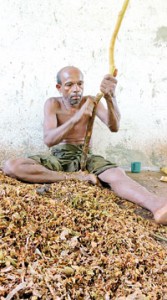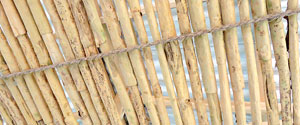Cinnamon Peelers
View(s):By Dhananjani Silva
Today, our ‘People at Work’ column will focus on Cinnamon peeling.
Cinnamon peeling is a specialized task. The process begins with peelers cutting the bulk of tender shoots from the cinnamon plantations.

Scraping the outer bark
In a cinnamon plant, you get multiple stems so cutting the stems is something you need to do carefully as any damage caused to the plant would affect the yield thereafter. Generally you cut only the tallest two or three shoots from each shrub using a special knife. The rest of the stems are left in the shrub for growing, as one shrub has the potential to produce the yield twice a year.
Peelers then stack the bulk of these long yellow stems in a shed to prepare for peeling.
The first step is to remove the outer tissue of the stem to separate it from the inner stem by scraping it with an oval shaped small knife. Next, the peelers are seen rubbing a brass rod on the bark. This activity continues for some time until the bark is loosened from the hard wood. The rest of the peeling activity is done using a small knife – here the bark are joined together by overlaps and the hollow of which is filled with smaller pieces, to make a long, firm quill of about three and half feet.

Cinnamon quills drying on the mesh.
The cinnamon quill is then left for drying on a string mesh inside a shed for about a day. However, they are not exposed to direct sunlight. After about a day, the quill is rolled on a hard flat surface – generally on the floor, until the crust of the cinnamon quill is smoothened.
It is then left for drying on the mesh, inside for another three or four days. Hundreds of quills are then tied into a bundle for delivering. Pure Ceylon Cinnamon, a prominent agricultural crop is a widely used spice variety. According to information from the Spice Council Sri Lanka, cinnamon originated in the central hills where several species of cinnamon occur sporadically in places such as Kandy, Matale, Belihuloya, Haputale and the Sinharaja forest range. At present, cinnamon cultivation is spread across the coastal belt stretching from Kalutara to Matara.
Pix by Athula Devapriya


